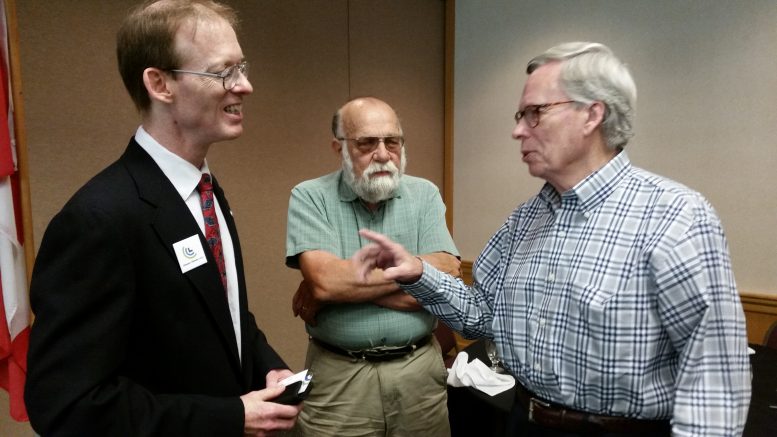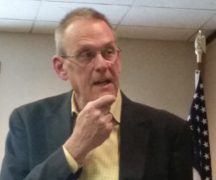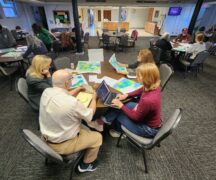By JAN LARSON McLAUGHLIN
BG Independent News
Growing up as a Boy Scout, Bob Clark-Phelps believed in the camping mantra, “Leave no trace.”
As an engineer with First Solar, Clark-Phelps knows it is no longer possible for humans to leave the earth unscarred for future generations. But he’s not yet given up on leaving behind the best planet possible.
Clark-Phelps, who had been with First Solar for six years, spoke about climate change on Thursday to the Bowling Green Kiwanis Club.
A large majority of Americans believe that climate change is occurring and should be met with policies, he said. However, the people able to make those policies don’t seem to have the stomach to do so. And debates on the topic are increasingly polarized.
“All we’re missing is the political will to get it done,” he said. “It’s not going to go away on its own.”
Clark-Phelps referred to a Yale Climate Study, which gauged the public’s views on global warming. More than two-thirds of those studied said climate change is happening, with 54 percent saying it is caused by humans.
Meanwhile, 97 percent of publishing climate scientists agree that global warming is occurring. “There’s almost unanimity,” he said.
But less than half of the people surveyed know that the vast majority of scientists back the climate change theory. That may be because journalists are trained to present all sides of controversial issues. So in an attempt to present balanced reporting, it may appear that both sides of the climate change issue are well supported by scientists. But that simply isn’t true, Clark-Phelps said.
Even with climate deniers getting news time, nearly three-quarters of Americans studied agreed that the U.S. should regulate carbon dioxide as a pollutant.
“Why is there continuing division and policy paralysis,” Clark-Phelps asked.
The evidence can be seen and felt all around the world, he said.
The increasing number of forest fires out west are worsened by higher temperatures, less snow, drought conditions – all of which lengthen the fire season.
“Climate change is a massive risk multiplier,” Clark-Phelps said.
Some researchers predict forest fires in the western U.S. will increase by six times by the year 2050.
In Florida, pumping water back into the ocean is becoming commonplace as the state loses its coastline.
“Florida is a place where it floods on sunny days now,” he said.
In Alaska, the glaciers are disappearing and the roads are crumbling as the permafrost melts beneath them.
In Ohio, climate change takes the form of excess rain from heavy downpours and higher temperatures – which add up to harmful algal blooms. According to Clark-Phelps, the Cincinnati area has experienced seven 100-year floods in the last 14 years.
While the warmth and rain are creating a longer growing season now in Ohio, in the long run the trends will suppress crop yields, he said. Clark-Phelps, who just returned from a work trip to Germany, said that nation is seeing a 20 percent drop in grain production this year – blamed on climate changes.
Still a Boy Scout at heart, Clark-Phelps is an optimist.
He is part of an organization called the Citizens’ Climate Lobby that is working with diverse groups of people to come up with some answers.
“We are creating the political will for climate solutions,” he said.
The solution must have bi-partisan support – so policies don’t change from one administration to the next.
The best proposal, he said, is a carbon fee and dividend program. The idea is to assess a fee on fossil fuels at their source or port of entry. Those fees would then be returned to U.S. households. The fees would start at $15 a ton for carbon dioxide, and grow by $10 a ton per year.
The plan protects low and middle income families, and stimulates the economy as the dividends are spent. Calculations predict the plan would lead to a 90 percent reduction in greenhouse gas emissions, 2.8 million new jobs over 20 years, and 200,000 lives saved over 20 years due to less pollution.
As the price of fossil fuels reflects the true cost, then more emphasis will be placed on renewable energy like wind, solar, hydro and also nuclear, Clark-Phelps said.
Those supporting the carbon fee proposal vary. Many are conservative Republicans like James Baker and George Schultz. And many oil companies like Exxon, BP and Shell are also on board.
“They know that something has to be done,” Clark-Phelps said.
So far, 86 members of Congress are also on board with a Climate Leadership Council.
“We cannot truly leave no trace,” he said. However, we can work to slow the damage. “The choice is ours to make.”
Sixty percent of Ohio’s electricity is still made from burning coal. Many areas are turning to natural gas as a “bridge fuel.” The cheap and plentiful gas has killed most of the coal use – not renewable energies that are usually blamed, Clark-Phelps said.
“That’s not discussed much,” he added.
But natural gas is not clean energy, he said. It also creates carbon dioxide emissions.
“We need to be thinking beyond that as well,” Clark-Phelps said.
Meanwhile, locally First Solar is building a new plant in Lake Township that will be the largest solar manufacturing plant in North America. The plant represents an investment of $400 million, and promises to create 500 new jobs.
Also locally, Clark-Phelps said after the meeting that Bowling Green’s power is cleaner than many communities due to its reliance on solar and wind energy.
“You are an inspiration,” he said to Bowling Green Mayor Dick Edwards.





